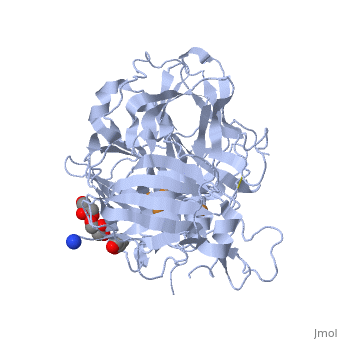Function
Laccase (Lac) or multicopper oxidase is a multi-copper protein which uses molecular oxygen to oxidize various aromatic and non-aromatic compounds by a radical-catalyzed reaction mechanism[1]. The multi-copper oxidases constitute a family of enzymes whose principal members are laccase (benzenediol oxygen oxidoreductase, EC 1.10.3.2), ascorbate oxidase (L-ascorbate oxygen oxidoreductase, EC 1.10.3.3) and ceruloplasmin (Fe(II) oxygen oxidoreductase, EC 1.16.3.1).
- Laccase 2 (Lac2) acts in lignin degradation and in detoxification of lignin products. Typically, laccases show a three cupredoxin-domain folding[2].
- Two-domain laccase or small lactase have unusual resistance to inhibitors[3].
- CotA laccase belongs to the multi-copper oxidase family. Similar to the other laccases the three dimensional structure of CotA 1w6l comprises three cupredoxin domains and four copper ions organised in :
a and .[4][5]
For laccase with nitrotyrosine modification see Nitrotyrosine.
Relevance
Laccase from various fungi is used in adsorption of dyes from polluted environment</ref>[6]. Laccases play an important role in food industry, paper and pulp industry, textile industry, synthetic chemistry, cosmetics, soil bioremediation and biodegradation of phenolic pollutants[7].
Structural highlights
The trinuclear center of CotA laccase has two type 3 copper ions, that can be anti-ferromagnetically
coupled through an hydroxyl moiety in between them, and one
type 2 copper ion.‡ The mononuclear copper is able to accept an
electron from a variety of phenolic substrates and then transmit
it to the trinuclear centre.
3D structures of laccase
Laccase 3D structures

